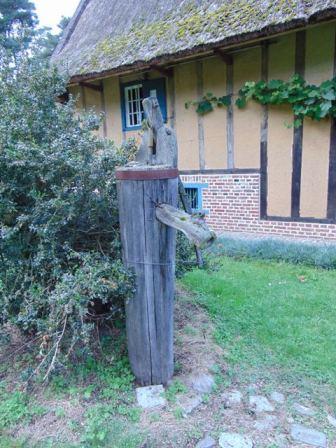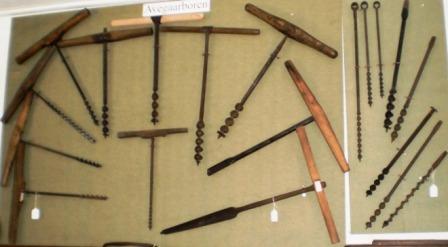Pumps can also be made entirely of wood. Especially in the north of the Netherlands many farms have one in the yard. For this purpose, oak, elm, larch or pine were used. There were selected sufficiently thick, straight trunks, of the length that was needed in order to reach up to the groundwater in the well.
The central taproot of the stem was sometimes carefully harvested. Which became then the lower pump part that came into the groundwater.
The trunks were watered at least 3 months, and stripped of bark and bacon (:cambium: last accrued timber, the outer year ring).
Sometimes the stem was first cut or chopped squared, for easier work.
 The strain was securely fastened to two trestles, at a comfortable working height (80 cm).
The strain was securely fastened to two trestles, at a comfortable working height (80 cm).
With a blemish rope in the middle was a chalk line designed to target the drill straight.
With a predecessor (short drill) was made a hole of about 10 cm. Then there was placed the long pump drill in line with the chalk line also on a fixed fulcrum, of which already the horizontal direction was good. Often, the drill with a diameter of 3 to 5 cm existed from connectable extensions.
Two men operated the drill (auger), the third kept constant an eye on the direction. Depending on material, muscle strength, type of wood, length and experience here was quietly 5 hours work.
Thereafter, the borehole was further removed with wider drilling or a drill spoon, up to 6 cm in diameter.
The upper part, the pump casing, was over a length of 130 cm culled to 8.5 to 12 cm. The transition between the narrow and the wide portion is conical.
The bottom was made close. 30 (50) cm high, there was a hole in the front, so that sand and sediment not ended up from the bottom of the well in the pump.
In the conical transition an elm valve is sealed with leather or flax (candle or sheep) wax, and fastened at one side with a strip of leather. Ahead comes a similar pump bucket hanging from the pump trigger (long wooden stick) that is operated by a lever on the outside (crank).
The whole could weigh up to 200 kg.
Especially the making of the drill is a huge skill that probably few (if any) contemporary forges yet master.
 It seems to me it should be able as well to make a water pump with a bellows with valves. But I have seen until now nowhere such a thing.
It seems to me it should be able as well to make a water pump with a bellows with valves. But I have seen until now nowhere such a thing.
To transfer surface water to a higher level, the auger, windmills and water wheels were used. On the blades of the wheel collectors are mounted obliquely. Under water, they fill up. And by the inclined mounting they pour over the highest point their contents meters higher again. These noria’s were (with aqueducts) used for irrigation (water management in agriculture). (See separate article.)
